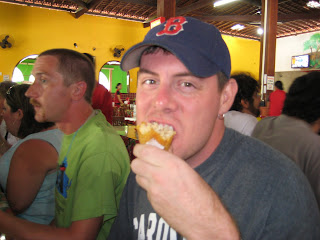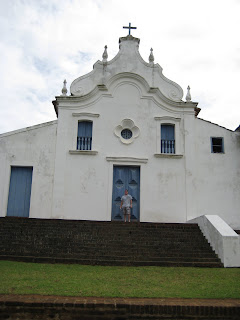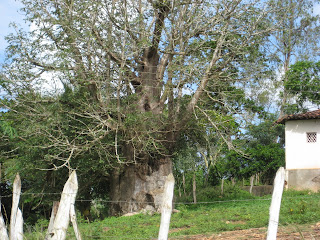Today was another interesting day. Our first activity was visitng a sugar cane factory and plantation in the state of Pernambuco. We then visited the town of Vicencia and observed local market trends.
On the ride to the sugar cane factory I was able to talk to our Brazilian tour guide, who is a professor, about some interesting subjects. I had wrongly assumed Antonio was of Portuguese descent, never assume. Antonio's family actually came from Italy to Brazil in 1910. It was much easier for immgrants from Italy to adapt to Brazilian culture than most immigrant groups. The reason being the similarities between Italian and Portuguese culture. His family made copper cauldrons which were then used in the sugar cane plantations.
I also learned that after the slaves were freed in Brazil the plantation owners searched for other ways to find workers. Their solution was indentured servants. Many Japanese and Italian immigrants signed contracts to work for a number of years with the intention of eventually being granted citizenship. I was fascinated to learn this. Eventually the process of indentured servitude ended in the early 1930's. Back to the Japanese, the place with the most amount of Japanese people, other than Japan, is Sao Paulo in Brazil.
I also found out that Brazil trades a lot of its products with Middle Eastern countries. In fact a good deal of chickens raised in Brazil are sent to Saudi Arabia. Brazil also exports a good amount of automobiles to the Middle East as well. I was told that Brazilian construction workers and engineers went to the Middle East to help build that regions infrastructure- roads, bridges, dams. I wonder if this is how the contacts were formed that eventually led to trade partnerships.
After about an hour and a half ride to the northern part of Pernambuco we arrived at the sugar cane mill. The name of the sugar cane company is Laranjeiras. The plantation is from the 16th century. The family that presently owns the plantation bought it in the 1950's. Before I forget, I had no idea but the reason why the sugar gets its white color is that they mix the sugar, chemicals and cow bones. The mill also has an alcohol distillery. The alcohol is not used for drinking but rather it is used as another energy source, ethanol. Ethanol is very popular in Brazil now.
The fastest growing market right now for Brazilian sugar is Africa. The plantation employs a total of 4,000 workers. Many of these workers are seasonal and only work when the cane is harvested. 800 workers are full time employees, they mainly work in administration and maintenance. The workers that work in the fields are guaranteed a minimum grower wage. In Pernambuco that wage is 615 real a month. Coca Cola is one of the biggest buyers of sugar in this region. Pernambuco is the 2nd largest producer of sugar in Brazil. However some of the western states are beginning to provide more competition. These states are offering incentives for sugar companies ,in the east, to relocate to their location.
Sugar Cane Mill-conveyer belt taking the sugar to be boiled
Sugar Cane Mill
Church at the mill from the the early 1800's. Sitting on top of the hill which is the custom. Catholicism is the major religion.
The factory we visited owned 10,000 acres of sugar fields, a massive amount of land. The workers in the field usually are only able to work 10 years. The reason is that they are often subjected to large amounts of smoke when the field is burned. They do not wear masks and of course their health is affected tremendously the longer they work. The cane is burned so that the layers of leaves are taken away making it much easier to cut and this saves time. I also learned today that not all of the sugar cane has the same quality. There is a tool used to measure the sugar level of each particular plant. Back in the day factory owners would send testers to fields and say the quality of the sugar was poor to drive out certain field operators that were uncooperative or wanted too much for their crop. The first sugar cane plantation was started in 1517. The sugar was brought from India and it took off in the New World. In September when the sugar cane is harvested airports are closed due to the smoke created when the burning of the fields occur.

Ouch that sugar cane is sharp! It grows over six feet too. What a terrible face.
In the particular town that you will see below the mill is original. This mill is from the 1600's. The slave houses that were once there are no longer there. However what remains are the trees. Where the slave houses once stood there are still the Baobo trees that were planted when the first slaves came. The trees are native to Africa. Why would there be native trees that only grow in Africa at this plantation? The trees were planted by the Portuguese to make slaves feel more comfortable. The slaves would hold ceremonies near the trees and perform traditional dances from their far away home.
Standing outside one of the oldest churches in Pernambuco. Think of all the history that this church has witnessed.
The domestic slaves would stay in these quarters.
Beaufiful view of the surrounding area. That is the original mill down at the bottom of the hill.
Courtyard next to the church
Inside of the church. A wedding was being prepared for that night.
Picture of the village back in history. I reflected a good deal on what went on here : (
I got attacked by bats, not expecting that one. I screamed like a little girl and ran.
The African Baobo Tree-planted by the Portuguese to make the slaves feel more at ease
Notice the trunk of the tree, enormous
I felt a wide array of emotions at the plantation. Me being the history enthusiast I am, I could not help but transform myself in time. Picturing and imagining what life must of been like at this plantation 300 years ago. Much of the area looks the same. The church at the top of the hill is original. The landscape has not changed much in 400 years. I feel so sad thinking about what those slaves must have felt and experienced. The Portuguese were very hard on their slaves. Just like most slave masters. The work of producing sugar cane is very labor intensive. I just kept thinking this is the same piece of land where domination, inequality and subjugation occurred. It was a very eerie feeling being there. I will never forget the emotions I felt on this day. The site of the plantation that has changed very little through time.
After the plantation we went to a small town for lunch. The food was amazing. However we had a little bit of an uncomfortable experience. There was one man that was extremely loud and obviously had had too much to drink. He was walking around and being a nuisance around other tables. Then he eventually made it to our table. The man approached my friend and started rubbing my friends head and saying certain things rather loudly. At first it was funny because it was just once and he left. But then he came back and would not stop. Eventually he left the restaurant altogether. Well wouldn't you know it but he comes back. He not only comes back but he begins to bother my friend again. At this point I am shocked and upset. I finally had enough and asked the manager if he could get rid of this belligerent man that was ruining our meal. The manager was very nice and understood. He took control of the situation and the man was asked to leave which after some persuasion he finally did. I am just really thankful that my friend kept his cool and the man left without something bad happening. It was really awkward and uncomfortable. It is a shame the great meal was overshadowed by this unfortunate occurrence.

Yummy, Yummy in my Tummy
The last activity was touring the town of Vacencia. We were divided into three groups. Our task was to go around the various shops and find ten different products and find out where the products were made. We found a good deal of American products. However the American products were actually produced in Brazil. What we learned was that Brazil produces a good deal of products in their own country. Certainly a positive thing for them. Antonio later told us that Brazil has strict policies on the importation of foreign goods. They are obviously trying to protect their own businesses. This of course makes sense, for it is more expensive to buy foreign goods so people buy Brazilian products for they are cheaper and more affordable.
This old woman was so sweet.
We made the local newspaper. Check it out this Tuesday. I will put a link up.
I love wandering off. I walked into an alley and found this little boy. I played soccer with him for ten minutes. What a cutie he was.
Here is his brother and grandma. You can't see the mother but she asked me where I was from and was very friendly just like all the Brazilians we have encountered.
Vicencia




















































